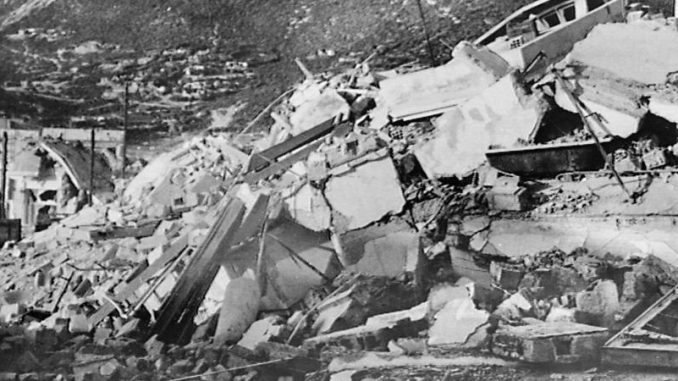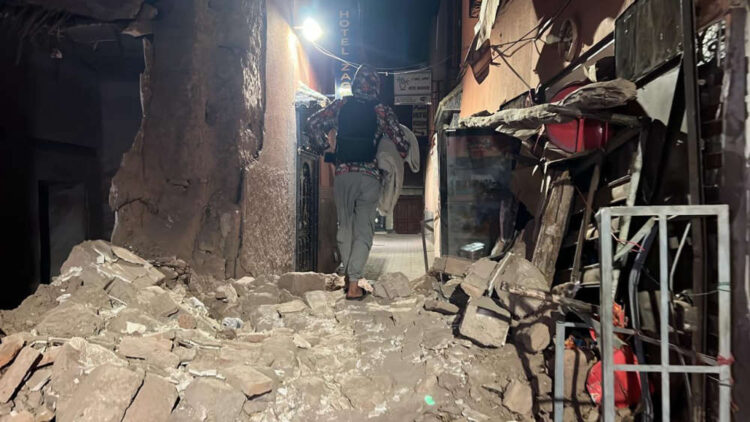By Ben Kerrigan-
More than 1,000 people have been killed and hundreds injured following a 6.8 magnitude earthquake in Morocco, state TV says.
Many of the fatalities are in hard-to-reach areas south of Marrakech.
Morocco’s armed forces have been mobilised to support the emergency response to the earthquake.
Turkey has also said it is ready to send 265 personnel and 1,000 tents to Morocco to support aid efforts following the deadly earthquake, according to AFAD, Turkey’s Emergency Management Authority.
In a statement, AFAD said it is responding to calls for international aid from Morocco. “A total of 265 personnel from AFAD, Ministry of Health’s National Rescue Team UMKE, Turkish Red Crescent and other NGOs are ready to take action,” it said.
The epicentre was high in the Atlas Mountains – about 43 miles (70km) away from Marrakech, a popular tourist destination.
The earthquake struck late on Friday, damaging buildings and sending panicked people pouring into the streets. Over 600 people were injured and are being treated in hospital.
“Where destructive earthquakes are rare, buildings are simply not constructed robustly enough to cope with strong ground shaking, so many collapse resulting in high casualties,” Bill McGuire, professor of geophysical and climate hazards at University College London said.
In Marrakech, which is a UNESCO World Heritage Site collapsed and big cracks now dissect a section of the medieval city’s walls.
Local television stations broadcast pictures of a fallen mosque minaret, with rubble lying on smashed cars. Others were seen screaming as they ran out of shopping centres and restaurants.
Officials are working to clear roads so ambulances and aid can reach those affected – but large distances between mountain villages mean it will take time to learn the full extent of the damage.
Local media reported that roads leading to the mountain region were jammed with vehicles and blocked with collapsed rocks, slowing rescue efforts.
Many spent the night outside over fears of an aftershock bringing more damage.
Montasir Itri, a resident in the mountain village of Asni not far from the epicentre, said most houses were damaged – adding: “Our neighbours are under the rubble and people are working hard to rescue them using available means in the village.”
In the village of Amizmiz, rescue workers picked through the rubble.
“When I felt the earth shaking beneath my feet and the house leaning, I rushed to get my kids out. But my neighbours couldn’t,” said Mohamed Azaw.
Rescuers in the village of Amizmiz search for survivors
“Unfortunately no one was found alive in that family. The father and son were found dead and they are still looking for the mother and the daughter.”
About 20 men including firefighters and soldiers stood on top the ruin of a house in Amizmiz as they tried to remove rubble, bits of carpet and furniture protruding from gaps between pancaked concrete floors.
Aftershocks have been reported – with men, women and children staying out in the streets, frightened of further quakes.
According to the US Geological Survey (USGS), the earthquake was at a relatively shallow depth of 11.5 miles (18km).
This is one of Morocco’s strongest earthquakes in years – and although they are relatively rare, a 5.8 magnitude tremor in 1960 caused thousands of deaths.
Seismic Profile Of Morocco
Morocco, a land known for its stunning landscapes, vibrant culture, and rich history, is not often associated with seismic activity. However, beneath its serene surface, this North African nation has experienced its share of powerful earthquakes that have shaped both its physical landscape and its people’s resilience.
Morocco’s geographical location places it at the crossroads of the African and Eurasian tectonic plates, making it part of the complex and dynamic Mediterranean region. This position exposes the nation to potential seismic hazards, including earthquakes. While Morocco does not sit atop a major plate boundary, it is still susceptible to seismic activity due to its proximity to several smaller faults and tectonic interactions.
Historical Earthquake
The Great Agadir Earthquake (1960)
One of the most devastating earthquakes in Morocco’s modern history occurred on February 29, 1960. Known as the Agadir Earthquake, it struck the coastal city of Agadir with a magnitude of 5.7 on the Richter scale. The destruction was immense, with entire neighborhoods reduced to rubble. The official death toll exceeded 15,000 people, making it one of the deadliest earthquakes ever recorded in North Africa.
This tragic event not only reshaped Agadir but also prompted changes in Moroccan building codes and disaster preparedness.
 On 29 February 1960, the city of Agadir, southwest of Morocco, was wiped off the map by earthquake that killed 12,000 people. Some 25,000 were injured and the city collapsed.
On 29 February 1960, the city of Agadir, southwest of Morocco, was wiped off the map by earthquake that killed 12,000 people. Some 25,000 were injured and the city collapsed.
Agadir, a popular tourist destination, bore the brunt of the earthquake. The city had to be rebuilt from the ground up, incorporating modern seismic-resistant construction techniques. This transformation ultimately turned Agadir into a model for earthquake-resilient urban planning.
The Al Hoceima Earthquake (2004)
On February 24, 2004, Morocco experienced another significant earthquake, this time centered near the city of Al Hoceima in the northern Rif region. With a magnitude of 6.3, the quake resulted in extensive damage and a death toll of over 600 people. The Al Hoceima Earthquake highlighted the need for ongoing vigilance and preparedness, especially in regions with a history of seismic activity.
This earthquake spurred Morocco to enhance its seismic monitoring systems and further develop its capacity to respond to disasters. Additionally, it underlined the importance of educating the public about earthquake preparedness.
Morocco’s earthquake history tells a story of seismic events that are relatively rare but nonetheless impactful when they occur. Unlike regions along major plate boundaries, where earthquakes are frequent and expected, Morocco experiences less frequent seismic activity. However, when these events do transpire, their impact is deeply felt due to the nation’s limited experience and preparedness.
Earthquake Risk in Morocco
While Morocco may not be a seismic hotspot, its geological setting necessitates vigilance regarding earthquake risk. The nation is situated near the boundary of the African and Eurasian tectonic plates, and several smaller fault lines crisscross the region. This complex tectonic environment means that Morocco is not immune to seismic hazards, and its earthquake risk profile is influenced by various factors.
Morocco’s proximity to the convergence of the African and Eurasian plates, even though it is not directly on a plate boundary, exposes it to potential earthquakes resulting from the plate’s dynamic interactions.
Numerous fault lines traverse Morocco, representing potential sources of seismic activity. While these faults may not generate earthquakes as frequently as those along major plate boundaries, they remain a concern for the nation.
Earthquakes in Morocco can vary in magnitude and depth. Shallower earthquakes, while typically less powerful, may have a more significant impact on the surface. Deeper earthquakes, although less common, can still cause damage, especially if they are of a higher magnitude.
Morocco’s urban areas are growing rapidly, and the concentration of people in cities amplifies the potential consequences of earthquakes. Ensuring the resilience of these urban centers is paramount to disaster preparedness.
Ongoing Challenges
The rarity of significant earthquakes in Morocco underscores the need for continued investment in earthquake preparedness. Building codes, construction standards, and early warning systems have all evolved to mitigate seismic risks.
New construction adheres to earthquake-resistant standards is crucial. Retrofitting older buildings to meet seismic requirements is equally important.
Given Morocco’s location in the Mediterranean region, it is part of a broader seismic landscape. Collaboration with neighboring countries and international organizations can enhance earthquake monitoring and disaster response.




